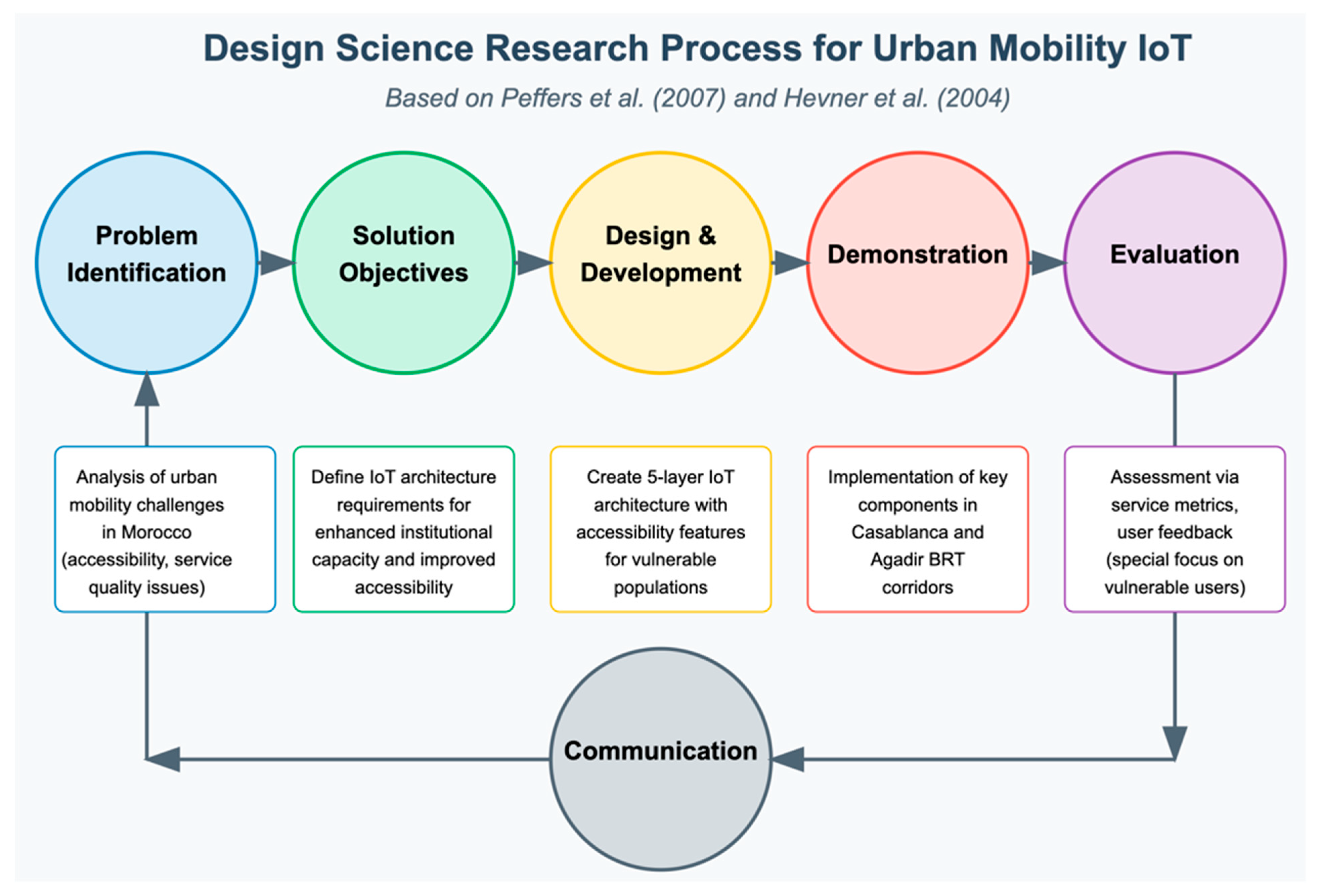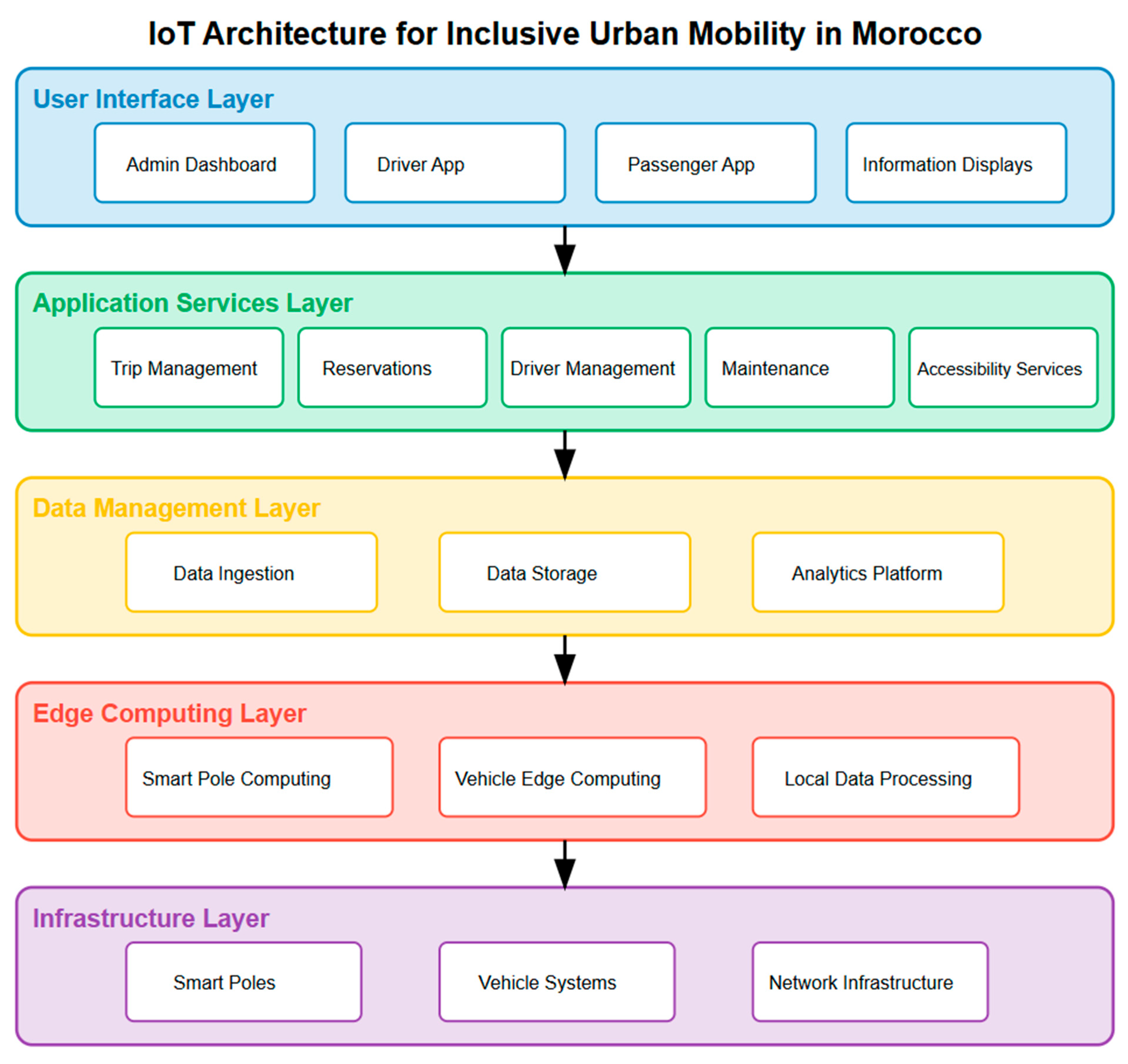IoT Architecture for Inclusive Urban Mobility: A Design Science Research Approach to Sustainable Transportation in Morocco †
Abstract
1. Introduction
2. Background and Related Work
2.1. Urban Mobility Challenges in Morocco
2.2. IoT for Urban Transportation
- Real-World Implementation Examples
2.3. Design Science Research Methodology
3. Problem Identification and Solution Objectives
3.1. Key Challenges in Moroccan Urban Mobility
3.2. Solution Objectives
4. Proposed IoT Architecture
4.1. Infrastructure Layer
4.2. Edge Computing Layer
4.3. Data Management Layer
4.4. Application Services Layer
4.5. User Interface Layer
5. Design Considerations and Proposed Implementation Framework
5.1. Proposed Phased Deployment Strategy
5.2. Gender Sensitivity and Universal Design
5.3. Sustainability and Energy Considerations
5.4. Architecture Evaluation
- Implementation Summary and Research Implications
6. Contributions
- Theoretical Contributions:
- Integrated Accessibility Framework: Our architecture introduces a novel approach that embeds accessibility as a foundational design principle. This principle applies across all architectural layers: infrastructure, edge computing, data management, application services, and user interfaces. This contrasts with existing models that often treat accessibility as an add-on feature limited to user interfaces.
- DSR Methodology in Socio-Technical Contexts: We show how Design Science Research can address challenges involving multiple stakeholders in developing nations [17,18]. The feedback process between stakeholders and technical components provides a model for balancing equity, efficiency, and sustainability.
- Evaluation Metrics for Inclusive IoT Systems: We propose an evaluation framework combining traditional IoT performance measures with inclusivity metrics like accessibility compliance and user satisfaction among marginalized groups.
- Practical Contributions:
- Deployment-Ready Blueprint: The architecture provides a modular, scalable implementation plan aligned with Morocco’s Urban Transport Program goals and investments [6]. Detailed specifications for components like solar-powered smart poles, wheelchair-accessible vehicle systems, and WCAG 2.1 AA-compliant interfaces enable immediate adoption by municipal authorities.
- Phased Implementation Strategy: Our 18-month rollout plan described in the Design Considerations and Proposed Implementation Framework minimizes risk by prioritizing high-impact components (e.g., real-time passenger information systems) while progressively integrating advanced features (e.g., predictive maintenance algorithms). This approach leverages existing infrastructure investments and institutional capacity-building initiatives [6,19].
- Policy and Procurement Guidance: The study offers actionable recommendations for updating procurement standards to include universal design requirements (e.g., tactile maps, audio beacons) and data privacy protocols tailored to Morocco’s regulatory landscape.
- Theoretical Validation in DSR
7. Conclusions
8. Future Work
- Expanding Geographic Scope: Adapting the architecture to smaller cities and rural areas, where infrastructure and user needs differ significantly from major urban centers, building on insights into sustainable transport in diverse developing world contexts [1].
- Long-Term Impact Studies: Monitoring the system’s performance over 3–5 years to assess sustainability gains, behavioral shifts in transport usage, and long-term cost–benefit ratios.
- Enhanced Accessibility Models: Developing AI-driven personalization tools (e.g., dynamic route adjustments for users with disabilities) and integrating augmented reality navigation aids.
- Policy Modernization: Collaborating with regulators to establish IoT-specific standards for data privacy, cross-agency data sharing, and inclusive design compliance.
Author Contributions
Funding
Institutional Review Board Statement
Informed Consent Statement
Data Availability Statement
Conflicts of Interest
References
- Pojani, D.; Stead, D. Sustainable urban transport in the developing world: Beyond megacities. Sustainability 2015, 7, 7784–7805. [Google Scholar] [CrossRef]
- World Health Organization; World Bank. World Report on Disability 2011; World Health Organization: Geneva, Switzerland, 2011. [Google Scholar]
- International Energy Agency. Global Energy & CO2 Status Report (for 2018 Data); Based on Information for 2018, Published March 2019; IEA: Paris, France, 2019. [Google Scholar]
- Zanella, A.; Bui, N.; Castellani, A.; Vangelista, L.; Zorzi, M. Internet of things for smart cities. IEEE Internet Things, J. 2014, 1, 22–32. [Google Scholar] [CrossRef]
- Silva, B.N.; Khan, M.; Han, K. Towards sustainable smart cities: A review of trends, architectures, components, and open challenges in smart cities. Sustain. Cities Soc. 2018, 38, 697–713. [Google Scholar] [CrossRef]
- The World Bank. Morocco Urban Transport Program PforR AF (P173048); World Bank: Washington, DC, USA, 2020. [Google Scholar]
- Conseil Economique, Social et Environnemental. Rapport Annuel 2019; CESE: Rabat, Morocco, 2019. [Google Scholar]
- Ministère de l’Energie, des Mines et de l’Environnement, Département de l’Environnement. Contribution Déterminée Au Niveau National-Actualisée; Ministère de l’Energie, des Mines et de l’Environnement, Département de l’Environnement: Rabat, Morocco, 2021. [Google Scholar]
- Conseil Economique, Social et Environnemental. La Mobilité Durable: Vers des Moyens de Transport Durables et Accessibles; Avis AS 53/2021; Conseil Economique, Social et Environ6nemental: Rabat, Morocco, 2021. [Google Scholar]
- Mehmood, Y.; Ahmad, F.; Yaqoob, I.; Adnane, A.; Imran, M.; Guizani, S. Internet-of-Things-Based Smart Cities: Recent Advances and Challenges. IEEE Commun. Mag. 2017, 55, 16–24. [Google Scholar] [CrossRef]
- Land Transport Authority; Intelligent Transport Society Singapore. Smart Mobility 2030: ITS Strategic Plan for Singapore; ITS Singapore: Singapore, 2014. [Google Scholar]
- Bakici, T.; Almirall, E.; Wareham, J. A Smart City Initiative: The Case of Barcelona. J. Knowl. Econ. 2013, 4, 135–148. [Google Scholar] [CrossRef]
- March, H.; Ribera-Fumaz, R. Smart contradictions: The politics of making Barcelona a Self-sufficient city. Eur. Urban Reg. Stud. 2014, 23, 816–830. [Google Scholar] [CrossRef]
- Okafor, K.C.; Achumba, I.E.; Chukwudebe, G.A.; Ononiwu, G.C. Leveraging Fog Computing for Scalable IoT Datacenter Using Spine-Leaf Network Topology. J. Electr. Comput. Eng. 2017, 2017, 2363240. [Google Scholar] [CrossRef]
- Alam, M.; Rufino, J.; Ferreira, J.; Ahmed, S.H.; Shah, N.; Chen, Y. Orchestration of Microservices for IoT Using Docker and Edge Computing. IEEE Commun. Mag. 2018, 56, 118–123. [Google Scholar] [CrossRef]
- Banks, A.; Gupta, R. MQTT Version 3.1.1. OASIS Standard. 2015. Available online: https://docs.oasis-open.org/mqtt/mqtt/v3.1.1/mqtt-v3.1.1.html (accessed on 7 June 2025).
- Peffers, K.; Tuunanen, T.; Rothenberger, M.A.; Chatterjee, S. A design science research methodology for information systems research. J. Manag. Inf. Syst. 2007, 24, 45–77. [Google Scholar] [CrossRef]
- Hevner, A.R.; March, S.T.; Park, J.; Ram, S. Design Science in Information Systems Research. MIS Q. 2004, 28, 75. [Google Scholar] [CrossRef]
- Ministère de l’Intérieur, Direction Générale des Collectivités Territoriales. Plan de Mobilité Urbaine Durable Guide Méthodologique; Ministère de l’Intérieur: Rabat, Morocco, 2023. [Google Scholar]


| Challenge | Description | Impact | Source |
|---|---|---|---|
| Institutional Capacity | Limited capabilities for planning, implementing, and monitoring infrastructure despite progress | Inefficient service delivery and resource utilization | [3] CESE Report, 2021 |
| Service Level | Commercial speeds dropping to ~5 km/h in dense urban areas during peak hours | Reduced productivity, increased travel time, poor quality of life | [4] World Bank Assessment, 2020 |
| Accessibility | 15–20% of citizens with limited mobility facing inadequate infrastructure | Social exclusion, reduced access to jobs, education, and health services | [5] CESE Report, 2019 |
| Environmental Sustainability | Transport sector accounting for 25% of energy consumption, producing 1/5 of GHG emissions, growing at 5% annually | Climate change, air pollution, negative health impacts | [6,7] AMEE Report 2019, Ministry NDC 2021 |
| Post-COVID Resilience | Pandemic exacerbating issues, potentially accelerating shift to private vehicles | Increased congestion, emissions, and social exclusion | [2] World Bank Report, 2020 |
Disclaimer/Publisher’s Note: The statements, opinions and data contained in all publications are solely those of the individual author(s) and contributor(s) and not of MDPI and/or the editor(s). MDPI and/or the editor(s) disclaim responsibility for any injury to people or property resulting from any ideas, methods, instructions or products referred to in the content. |
© 2025 by the authors. Licensee MDPI, Basel, Switzerland. This article is an open access article distributed under the terms and conditions of the Creative Commons Attribution (CC BY) license (https://creativecommons.org/licenses/by/4.0/).
Share and Cite
Abdennasser, T.; Alaoui, S.; Chlioui, I.; Hnini, A. IoT Architecture for Inclusive Urban Mobility: A Design Science Research Approach to Sustainable Transportation in Morocco. Eng. Proc. 2025, 112, 46. https://doi.org/10.3390/engproc2025112046
Abdennasser T, Alaoui S, Chlioui I, Hnini A. IoT Architecture for Inclusive Urban Mobility: A Design Science Research Approach to Sustainable Transportation in Morocco. Engineering Proceedings. 2025; 112(1):46. https://doi.org/10.3390/engproc2025112046
Chicago/Turabian StyleAbdennasser, Tarik, Souad Alaoui, Imane Chlioui, and Abdelhalim Hnini. 2025. "IoT Architecture for Inclusive Urban Mobility: A Design Science Research Approach to Sustainable Transportation in Morocco" Engineering Proceedings 112, no. 1: 46. https://doi.org/10.3390/engproc2025112046
APA StyleAbdennasser, T., Alaoui, S., Chlioui, I., & Hnini, A. (2025). IoT Architecture for Inclusive Urban Mobility: A Design Science Research Approach to Sustainable Transportation in Morocco. Engineering Proceedings, 112(1), 46. https://doi.org/10.3390/engproc2025112046






